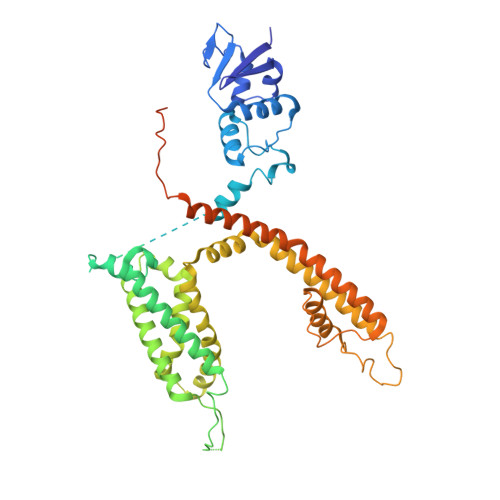Cryo-EM structure of the human Kv3.1 channel reveals gating control by the cytoplasmic T1 domain.
Chi, G., Liang, Q., Sridhar, A., Cowgill, J.B., Sader, K., Radjainia, M., Qian, P., Castro-Hartmann, P., Venkaya, S., Singh, N.K., McKinley, G., Fernandez-Cid, A., Mukhopadhyay, S.M.M., Burgess-Brown, N.A., Delemotte, L., Covarrubias, M., Durr, K.L.(2022) Nat Commun 13: 4087-4087
- PubMed: 35840580
- DOI: https://doi.org/10.1038/s41467-022-29594-w
- Primary Citation of Related Structures:
7PHH, 7PHI, 7PHK, 7PHL - PubMed Abstract:
Kv3 channels have distinctive gating kinetics tailored for rapid repolarization in fast-spiking neurons. Malfunction of this process due to genetic variants in the KCNC1 gene causes severe epileptic disorders, yet the structural determinants for the unusual gating properties remain elusive. Here, we present cryo-electron microscopy structures of the human Kv3.1a channel, revealing a unique arrangement of the cytoplasmic tetramerization domain T1 which facilitates interactions with C-terminal axonal targeting motif and key components of the gating machinery. Additional interactions between S1/S2 linker and turret domain strengthen the interface between voltage sensor and pore domain. Supported by molecular dynamics simulations, electrophysiological and mutational analyses, we identify several residues in the S4/S5 linker which influence the gating kinetics and an electrostatic interaction between acidic residues in α6 of T1 and R449 in the pore-flanking S6T helices. These findings provide insights into gating control and disease mechanisms and may guide strategies for the design of pharmaceutical drugs targeting Kv3 channels.
- Centre for Medicines Discovery, Nuffield Department of Medicine, University of Oxford, Roosevelt Drive, Oxford, OX3 7DQ, UK.
Organizational Affiliation:



















